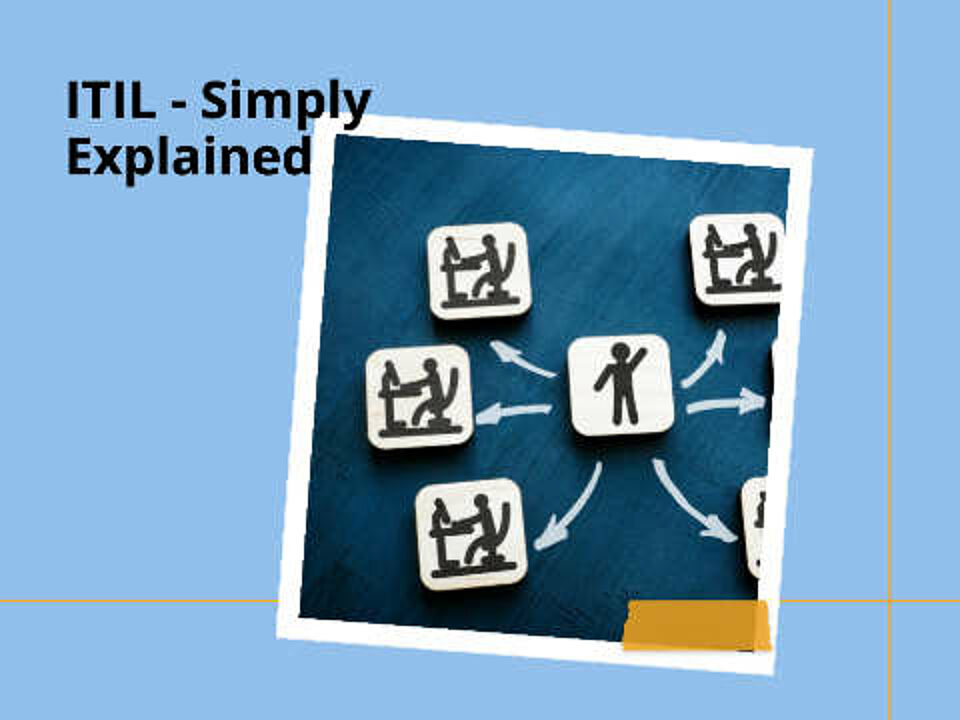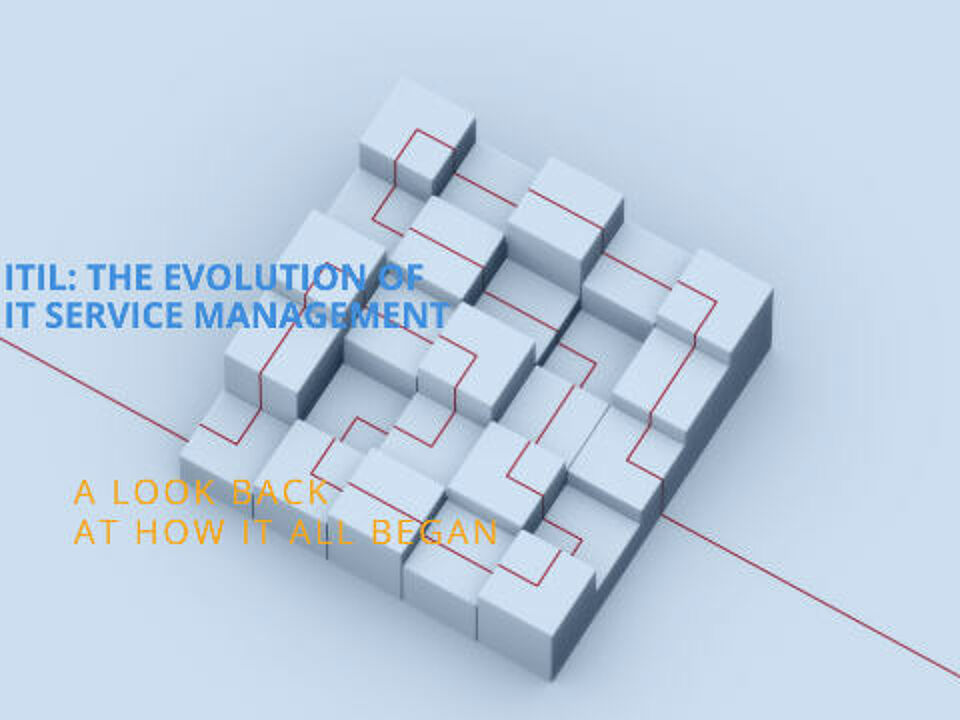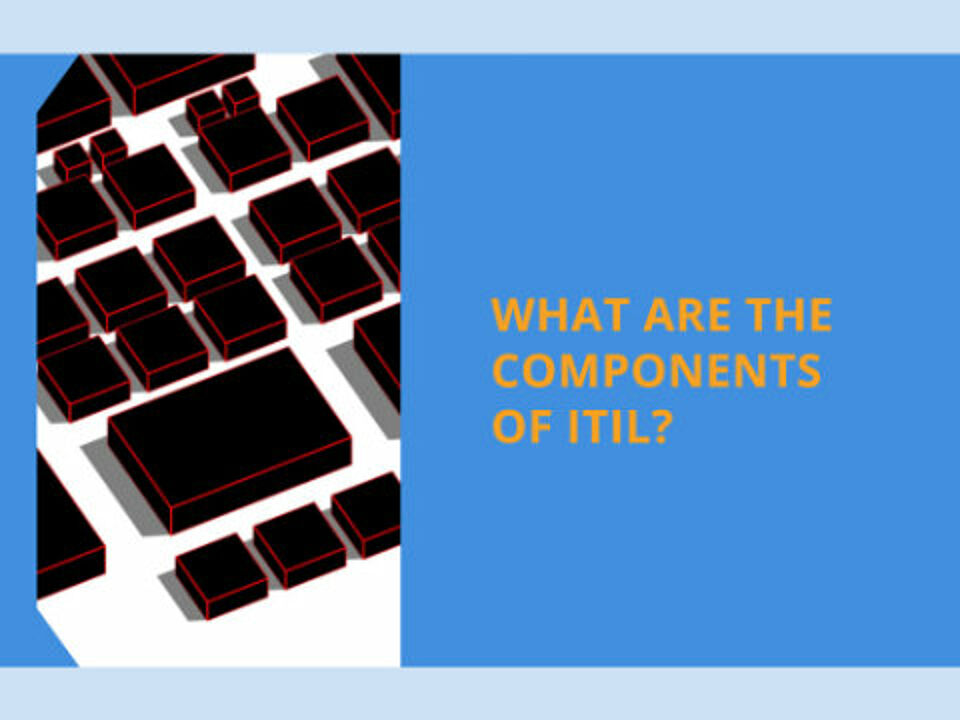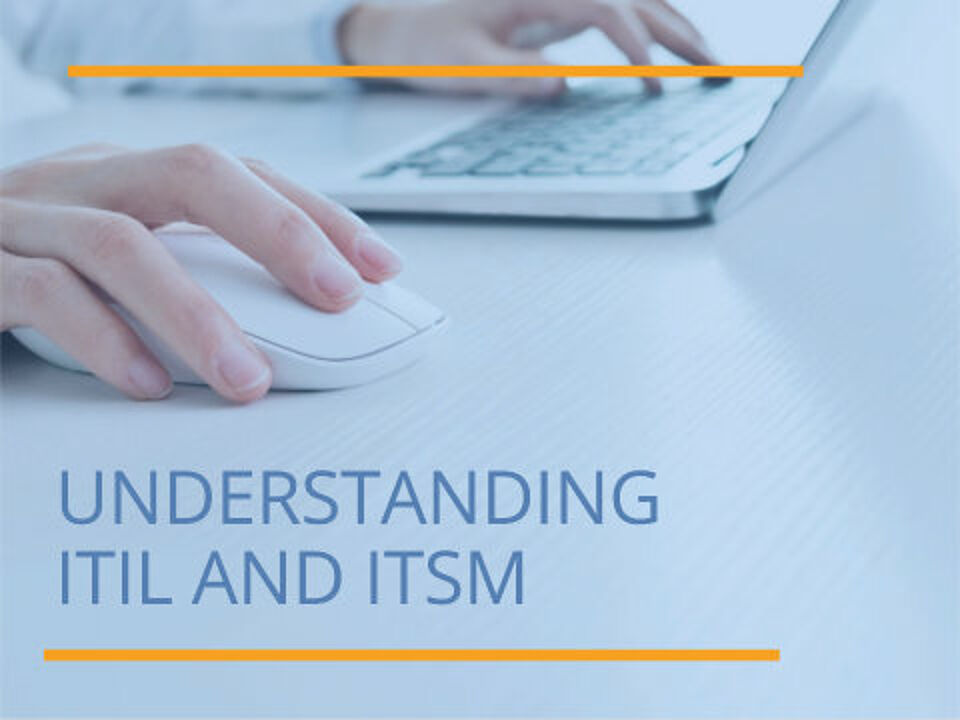
ITIL, which stands for "Information Technology Infrastructure Library", is a framework that helps companies to effectively plan, implement and manage their IT services. ITIL provides proven methods and processes that make it possible to improve the quality of IT services while controlling costs.
With the recent shift of work to remote locations due to the COVID-19 pandemic and the ongoing conflict in Ukraine, we have all become aware of the extent of our own digital transformation and what it means for our lives. The current situation has highlighted the importance of IT and IT services. IT serves as the rallying point for communications and critical business data, as it is responsible for providing optimal support for all processes, regardless of the company's size or industry. This is exactly why the "ITIL framework" has not lost its importance.
The ITIL library consists of a collection of best practices based on industry experience and developed by experts. These cover all aspects of IT service management, from strategy development to the continuous service improvement process. ITIL provides a common language and uniform standards for service management, enabling smooth collaboration between different IT departments and stakeholders.
One of the core ideas behind ITIL is to focus on the needs of customers and ensure that IT services meet their expectations. ITIL therefore defines clear processes and roles to ensure that IT services are delivered in line with business requirements.
Overall, ITIL provides a solid framework for organizations to optimize their services, increase customer satisfaction, and deliver high value across the enterprise. By establishing proven "best practices," ITIL becomes a valuable tool for organizations that want their IT department to be a strategic partner in their success.

Review
In the late 1980s ITIL, was developed by the British government agency Central Computing and Telecommunications Agency (CCTA). The CCTA was given a mandate to improve the quality of IT services purchased by the government while reducing costs, as previous services were considered to be deficient. To meet this goal, expedient and cost-effective IT service delivery practices were studied and compiled into a comprehensive catalog of proven best practices. This catalog later became known as ITIL and today enjoys worldwide recognition.
Traditionally, the focus of companies and IT organizations has been primarily on the technical side, such as software and hardware, often with insufficient consideration of customer requirements. IT Infrastructure Library, on the other hand, emphasizes the central importance of customer requirements and requires organizations to explicitly agree the IT services to be provided with their customers. This approach ensures that IT services are precisely aligned with the needs of customers, thus ensuring higher customer satisfaction.
Current ownership of the ITIL portfolio lies with AXELOS, who offer a comprehensive training and certification scheme designed to train ITIL experts. Organizations cannot directly certify to ITIL. However, the growing adoption of ITIL has led to the emergence of ISO 20000, the international standard for service management.

How and when does ITIL help?
ITIL enables IT departments to develop a proactive approach and drive continuous service improvements. The service management framework provides a structured approach to incident, problem, capacity management and many other areas of IT service management. By implementing ITIL, organizations can better control their IT services, improve customer satisfaction, and increase efficiency in the IT department.
Some examples:
- Unstructured approach: ITIL provides a structured approach to designing, implementing, delivering and improving IT services, which helps improve service quality and customer satisfaction.
- Unpredictable downtime: ITIL enables a systematic approach to problem and incident management to minimize downtime and ensure faster recovery.
- Poor service quality: By implementing ITIL processes such as service level management and configuration management, organizations can continuously monitor and improve their service quality.
- Unclear responsibilities: ITIL establishes clear roles and responsibilities for service management, leading to better collaboration and more effective decision making.
- Lack of transparency: ITIL provides mechanisms such as service catalogs and reporting to create transparency about the services provided and their performance.
- Poor resource management: ITIL helps optimize resources and budgets through better planning and prioritization of projects and activities.
- Difficulty in change implementation: ITIL has clear structure for change management to ensure structured and controlled implementation of changes.
- Lack of adaptability: ITIL emphasizes the importance of continuous improvement and agile methods to adapt to changing business requirements and technologies.

What components does ITIL contain?
ITIL contains various components that are oriented to the life of an IT service and provide comprehensive information and tools for the individual phases. An essential aspect covered by ITIL is strategy planning and control in the use of IT, which is summarized under the topic "Service Strategy".
The conception of ITIL takes place in the "Service Design" function, in which the exact requirements for the software are recorded and translated into an effective IT solution. In the subsequent "Service Transition" phase, the developed solution is implemented and transferred to operational use. Careful consideration of the design and interaction with other IT components is crucial to avoid failures.
In the third phase, "Service Operation", the focus is on continuously ensuring smooth IT service operations. An important task here is to install a communication instance that monitors all messages and immediately informs the IT support team as soon as a problem occurs. In addition, ITIL offers users suggestions and recommendations for "continuous service improvement" (CSI). Within this framework, existing IT landscapes, processes and personnel are subjected to a continuous improvement process in order to sustainably increase quality.
ITIL defines a number of core processes that can be implemented in IT service management. The most important ITIL processes include:
- Incident Management: IM focuses on the efficient handling and resolution of incidents in service operations. The goal is to minimize downtime and restore service quality.
- Problem Management: PM aims to identify the causes of recurring incidents and take action to resolve them sustainably. It is not only about solving problems, but also about taking preventive measures to avoid future problems.
- Change Management: CM ensures that changes to IT services are carefully planned, approved and controlled to minimize impact on ongoing operations. It includes identifying change requirements, analyzing impacts and risks, performing testing, and coordinating implementation.
- Release Management: RM deals with the planning, coordination and control of major changes or updates to IT services. It ensures that new versions or releases are deployed in a controlled environment to minimize potential impact on service operations.
- Configuration Management: This process involves collecting and managing information about the IT infrastructure and its components. It provides an accurate inventory of IT assets and their relationships to each other to effectively track changes and forecast impacts on service operations.
All of these topics are interrelated and interact to ensure the effective delivery and operation of IT services. They provide clear structure and direction for IT service management and enable continuous service improvement.
What represents the added value?
ITIL, as a set of rules, is instrumental in ensuring that IT aligns its activities with the specific requirements of the organization and focuses on meeting those requirements through delivered services. The resulting added value includes:
- Better alignment of IT departments with the overall organization to ensure effective goal achievement.
- Improved service times and higher requestor satisfaction through streamlined operations and smooth service processes.
- Reduced costs through more efficient use of digital, physical, and human resources.
- Increased visibility into IT costs and assets, enabling improved cost control.
- Optimized response and management of disruptions to continuously maintain business operations.
- More flexible service environments that can easily adapt to changes in requirements, ensuring high agility.

What is the difference between ITIL and ITSM?
ITSM (Information Technology Service Management) and ITIL (Information Technology Infrastructure Library) are two closely related terms, but they describe different concepts:
- ITSM (IT Service Management):
It is a comprehensive approach to planning, delivering, managing and improving agreed services in an organization. It refers to the set of processes, workflows, procedures and tools used to effectively manage IT services and create customer satisfaction. It focuses on the alignment of IT services with business requirements and aims to deliver quality services to users and customers. - ITIL (Information Technology Infrastructure Library):
ITIL is a specific collection of proven best practices for ITSM. It is a framework that provides detailed guidance and recommendations for structuring and executing processes. It provide guidance for planning, implementing and improving IT services at different stages of the lifecycle.
How does ITIL differ from IT Service Management (ITSM)?
The two are closely related, but not the same. ITIL is a framework that provides proven methods and best practices for IT service management. It provides a structured approach and best practices for IT service delivery. ITSM, on the other hand, refers to the set of activities, processes, workflows and standards implemented in organizations to effectively manage IT services and meet customer requirements. ITIL is a part of ITSM and provides specific methods and best practices to optimize IT service delivery.
Thus, ITSM is the comprehensive concept and has the idea of how IT services should be managed effectively, while ITIL is a concrete set of best practices and guidelines that serve as a guide for implementation. ITIL is one of the best known and most widely used frameworks for ITSM, but there are also other frameworks and standards that can be used in conjunction here, such as COBIT (Control Objectives for Information and Related Technologies) or ISO 20000.
Benefits of the ITIL Framework
The application and implementation of ITIL creates effective collaboration between IT and the entire organization, enabling business goals to be achieved in an efficient manner and creating sustainable added value. In the process, managers continuously receive suggestions for improving their IT landscape, which continually raises a company's IT service to a new level. These regular improvements lead to increased efficiency, agility and adaptability of the IT infrastructure to meet the changing needs of the business. In addition, the goal of ITIL is to improve visibility and control over IT processes, ensuring proactive problem resolution and optimized resource utilization. The combination of improved service and continuous development makes ITIL a valuable tool for service providers who want to use their IT department as a strategic success factor.

ITIL and a software certification
In the author's opinion, there are some reasons why it is not possible to have a software certified according to ITIL. ITIL is used in many companies, but it is simply not feasible to apply this framework to a software:
- ITIL was developed to support and improve the work of IT service teams. It is a framework based on processes and best experiences to optimize IT operations. It was not created to evaluate or certify software products themselves. Software can be ITIL compliant, but this does not automatically mean that it is ITIL certified. This is a big difference and is often misunderstood.
- ITIL is a comprehensive and complex framework. There are many different workflows and practices that are included. It is difficult and time consuming to review software to see if it meets all of these requirements. Not only would the software need to be examined to see how it supports the various libraries, but equally how it can integrate with other tools and technologies and how it can improve the overall IT service. This effort of testing would be almost unaffordable from the author's point of view. And reducing it to selected specific processes and workflows is a reduction.
- ITIL is a "living" framework. It is regularly updated and further developed to meet current requirements and trends in service management. This means that an ITIL certificate of a software cannot be permanent. Each new version of ITIL is a change to the certification requirements and the software would have to go through the process again.
The framework did not provide for certification of software in the past, nor in the current version - of people yes. ITIL is a tool in the service desk of IT departments. It is not a benchmark to evaluate or certify software.
Development of ITIL
The current ITIL versions in effect are ITIL 4 and ITIL v3. Version 4.0 was introduced in 2019 and is an evolution of previous versions. It was developed to meet the ever-changing requirements and challenges in IT service management.
ITIL v4 consists of a series of publications and modules that build on each other. The most important publication is the ITIL Foundation book, which provides an introduction to the fundamentals of IT service management. It explains the main concepts and principles of ITIL and shows how they can be applied in practice.
There are also more specific modules that focus on particular aspects of IT service management, such as Service Strategy, Service Design, Service Transition, Service Operation, and Continual Service Improvement. Each module provides detailed guidance and best practices for implementing ITIL in different areas.
Version 3, also known as ITIL 2011, also remains valid. This version was introduced in 2007 and updated in 2011. V3 includes five core books that cover all major aspects of IT service management. It also includes a set of processes, features and best practices that enable organizations to effectively plan, implement and operate their IT services.
Although version 4.0 is the latest version, version 3 is still used by companies. It represents an established method and helps to improve IT services.

ITIL and the Future: Far More Than Just an "IT Thing"
The world of information technology is constantly changing, and ITIL, that globally recognized framework for IT service management, is about to enter an exciting new era. The author estimates that starting in 2023, ITIL will evolve into an even more comprehensive and holistic solution to meet current and future needs.
ITIL will go beyond the pure IT sector and appeal to companies in all industries. At a time when service-oriented business models are becoming increasingly popular, ITIL is the answer to the needs of companies, regardless of their size or industry. The ITIL framework no longer focuses only on IT services, but also aims to improve the "user experience" and overall service quality.
Another development is the integration of agile methods into ITIL v4. Agile is no longer limited to software development, but has proven to be a successful way of working. With the introduction of agile principles in ITIL, companies can react faster to changes and customer requirements. A more flexible and dynamic environment is created in which innovations can be implemented more quickly.
Another important aspect is the convergence of the IT department and other departments within a company. ITIL processes will act as a link here to facilitate interaction between different departments and ensure smooth service delivery. This will lead to an increase in the overall performance of the company.
In addition, the possibilities for automating processes will be expanded. By using Robotic Process Automation (RPA), repetitive tasks will be automated, saving time and resources. This allows all teams to use their resources more effectively and focus on operational tasks.
In summary, the further development of ITIL helps companies that want to improve their performance and increase their competitiveness.
